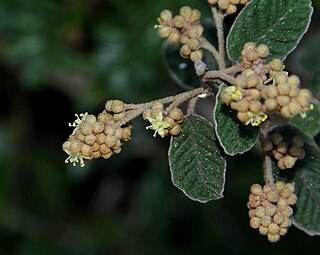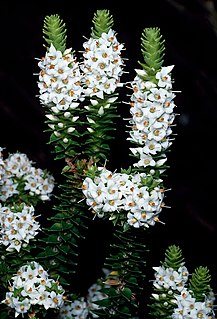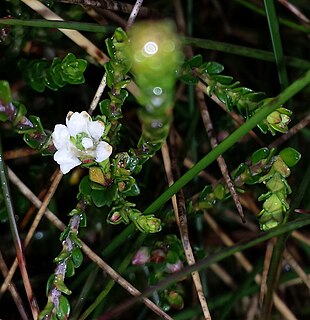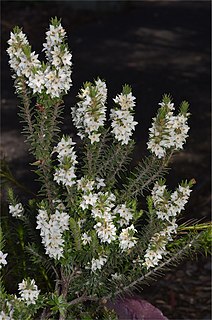
Pomaderris oraria, commonly known as Bassian dogwood, is a species of flowering plant in the family Rhamnaceae and is endemic to south-eastern Australia. It is a compact shrub with hairy branchlets, hairy, elliptic leaves and panicles of hairy, greenish to cream-coloured or crimson-tinged flowers.

Pomaderris paniculosa, commonly known as scurfy pomaderris, is a species of flowering plant in the family Rhamnaceae and is native to Australia and New Zealand. It is a shrub with hairy branchlets, round to elliptic or egg-shaped leaves with the narrower end towards the base and panicles of hairy, cream-coloured to greenish, sometimes crimson-tinged flowers.

Bossiaea tasmanica is a species of flowering plant in the family Fabaceae and is endemic to Tasmania. It is a prostrate or low-lying shrub with spiny branches, elliptic to egg-shaped with the narrower end towards the base, and yellow and red to pink flowers.

Epacris browniae is a species of flowering plant in the heath family Ericaceae and is endemic to a small area of New South Wales. It is an erect, woody shrub with wand-like branchlets, crowded, glabrous, trowel-shaped leaves and tube-shaped flowers with white petals.

Prostanthera canaliculata is a species of flowering plant in the family Lamiaceae and is endemic to the south-west of Western Australia. It is a small, erect shrub with hairy branchlets, narrow egg-shaped to narrow elliptical leaves and pale blue or pale violet to white flowers with no markings.

Epacris gnidioides, commonly known as Budawangs cliff-heath, is a species of flowering plant in the heath family Ericaceae and is endemic to a restricted area of New South Wales. It is a small, creeping shrub with hairy branches, sharply-pointed lance-shaped leaves, and tube-shaped, white flowers.

Pultenaea dentata, commonly known as clustered bush-pea, is a species of flowering plant in the family Fabaceae and is endemic to south-eastern Australia. It is an erect to low-lying or prostrate, open shrub with elliptic to narrow egg-shaped leaves and dense clusters of yellow, red and purple flowers.

Epacris crassifolia is a species of flowering plant in the heath family Ericaceae and is endemic to south-eastern New South Wales, Australia. It is a low-lying shrub with elliptic to egg-shaped leaves with the lower end towards the base, and tube-shaped, white or cream-coloured flowers clustered near the ends of the branches.
Hovea corrickiae, is a species of flowering plant in the family Fabaceae and is endemic to south-eastern Australia. It is a shrub or slender tree with densely hairy branchlets, narrowly egg-shaped or elliptic, dark green leaves with stipules at the base, and mostly pale to deep mauve, pea-like flowers.

Epacris apiculata is a species of flowering plant in the heath family Ericaceae and is endemic to a small area of New South Wales. It is a small, slender, low-lying to erect shrub with hairy branchlets, egg-shaped leaves with a thickened, pointed tip and tube-shaped flowers with white petals.

Epacris barbata, commonly known as bearded heath, is a species of flowering plant in the heath family Ericaceae and is endemic to a restricted area of Tasmania. It is an erect shrub with lance-shaped leaves and white, tube-shaped flowers with hairy sepals.

Epacris celata is a species of flowering plant in the heath family Ericaceae and is endemic to south-eastern continental Australia. It is a spreading to erect shrub with flat, elliptic to egg-shaped leaves with the narrower end towards the base, and tube-shaped white flowers clustered in upper leaf axils.

Epacris cerasicollina is a species of flowering plant in the heath family Ericaceae and is endemic to Tasmania. It is a shrub with lance-shaped to egg-shaped, slightly concave leaves and tube-shaped white flowers mostly clustered in upper leaf axils.

Epacris coriacea is a species of flowering plant in the heath family Ericaceae and is endemic to a eastern New South Wales. It is a slender, erect shrub with hairy branchlets, egg-shaped to more or less diamond-shaped leaves and tube-shaped, white or cream-coloured flowers.

Epacris curtisiae is a species of flowering plant in the heath family Ericaceae and is endemic to north-western Tasmania. It is a shrub with egg-shaped to almost circular leaves and tube-shaped white flowers crowded in upper leaf axils.

Epacris decumbens is a species of flowering plant in the heath family Ericaceae and is endemic to a restricted area of New South Wales. It is a straggling, low-lying shrub with hairy branchlets, elliptic to egg-shaped leaves, and tube-shaped, white flowers.

Leucopogon australis, commonly known as spiked beard-heath, is a species of flowering plant in the heath family Ericaceae and is endemic to southern Australia. It is an erect, aromatic shrub with narrowly egg-shaped to narrowly elliptic leaves, and white flowers arranged in spikes near the ends of branchlets.
Epacris exserta , commonly known as South Esk heath, is a species of flowering plant in the heath family, Ericaceae and is endemic to Tasmania. It is an erect shrub with narrowly lance-shaped to elliptic leaves and tube-shaped, white flowers clustered near the ends of the branches.

Epacris franklinii is a species of flowering plant in the heath family, Ericaceae, and is endemic to Tasmaina. It is an erect, spreading shrub with lance-shaped or elliptic leaves and white, tube-shaped flowers.

Epacris glabella, commonly known as smooth heath, is a species of flowering plant in the heath family, Ericaceae, and is endemic to Tasmania. It is a shrub with erect branches, egg-shaped to elliptic leaves and white, tube-shaped flowers.


















